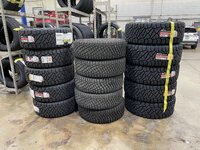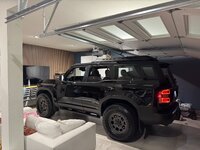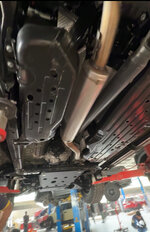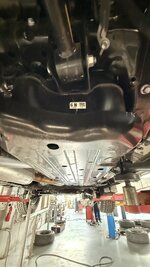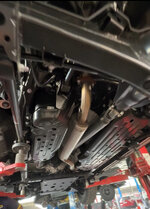Thanks for bringing the conversation back to topic . This picture shows how narrow they run compared to other 12.5 width tiresNot embarrassed one bit, I made a mistake and missed a few details and got tired of researching, simple as that. If I were embarrassed, I'd just delete or edit the post.
Rather than do the math why don't you put a tape measure to the tread width, I would like to see what it actually measures to and may help others trying to decide what tires to run? While you're at it measuring installed height on LC would be nice as well. The pictures of them show quite a bit of taper and allot of sidewall bulge (the amount of bulge could be due to a narrower wheel between what is pictured but that is unknown). Does the spare fit in the stock location in that size and specific tire?
Nice light weight setup! How ever they have only one purpose IMO (MPG improvement) from what I've read, no mileage warranty and a very soft compound (according to reviews) "C" load rated tire. Reviews on wear are pretty terrible from Raptor and Bronco owners running them. Most owners are reporting 33.5" -33.75" when installed under load, which happens to any tire, but they are not 35" tires to begin with and should either be referred to as their metric size or 34" tires when rounding and speaking of the inch conversion equivalent (34.4 rounds to 34).
There are also a few reports of sidewall failure on trails from the same owners.
My tires (pizza cutters) 255/80R17 @ 52lbs. are 10.1" section width (tread measures 7.75") and are 33.2" diameter (dia. measures 32.5" installed) and have 55k mile warranty. They are not the best tire out there in that size by no means but the lightest I could find without other compromises for my use case, and I'll probably go with something else next time as they are quite loud (likely due to tread depth of 18/32") but have otherwise been flawless IMO.
See below for the discussion the Bronco forum
Wheel width is 8.5 so no problem there .
In terms of height they are just as tall as bfgoodrich k02s in the same size .
The main reason I chose them for lc is
1. Lightest 35s on the market even lighter than most 33s
2. Narrow contact patch allows for clearance with only a 1 inch front lift.
Ofcourse there are compromises as with everything else . They are soft and likely more prone to punctures, and hold gravel but I’m willing to live with that for onroad comfort at mpg improvements
Attachments
Last edited:
